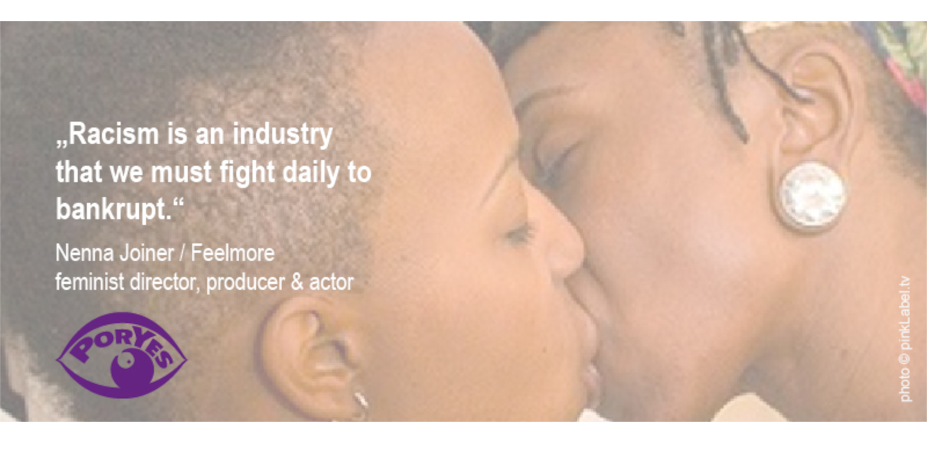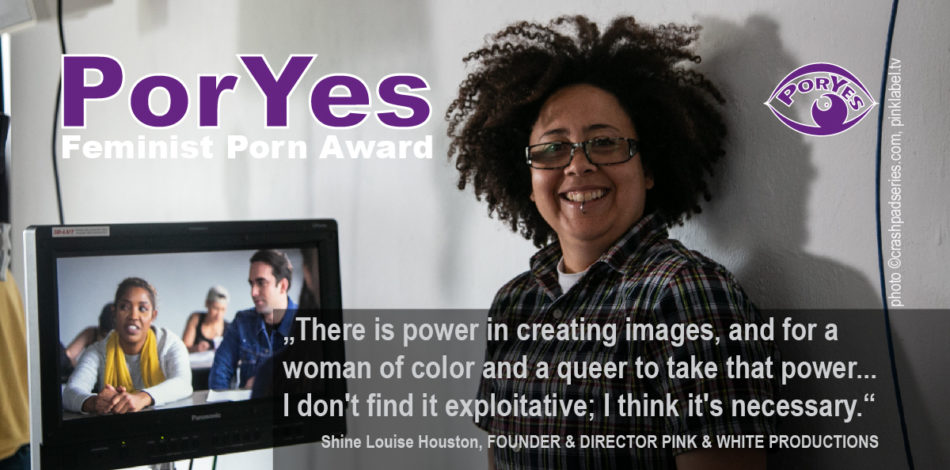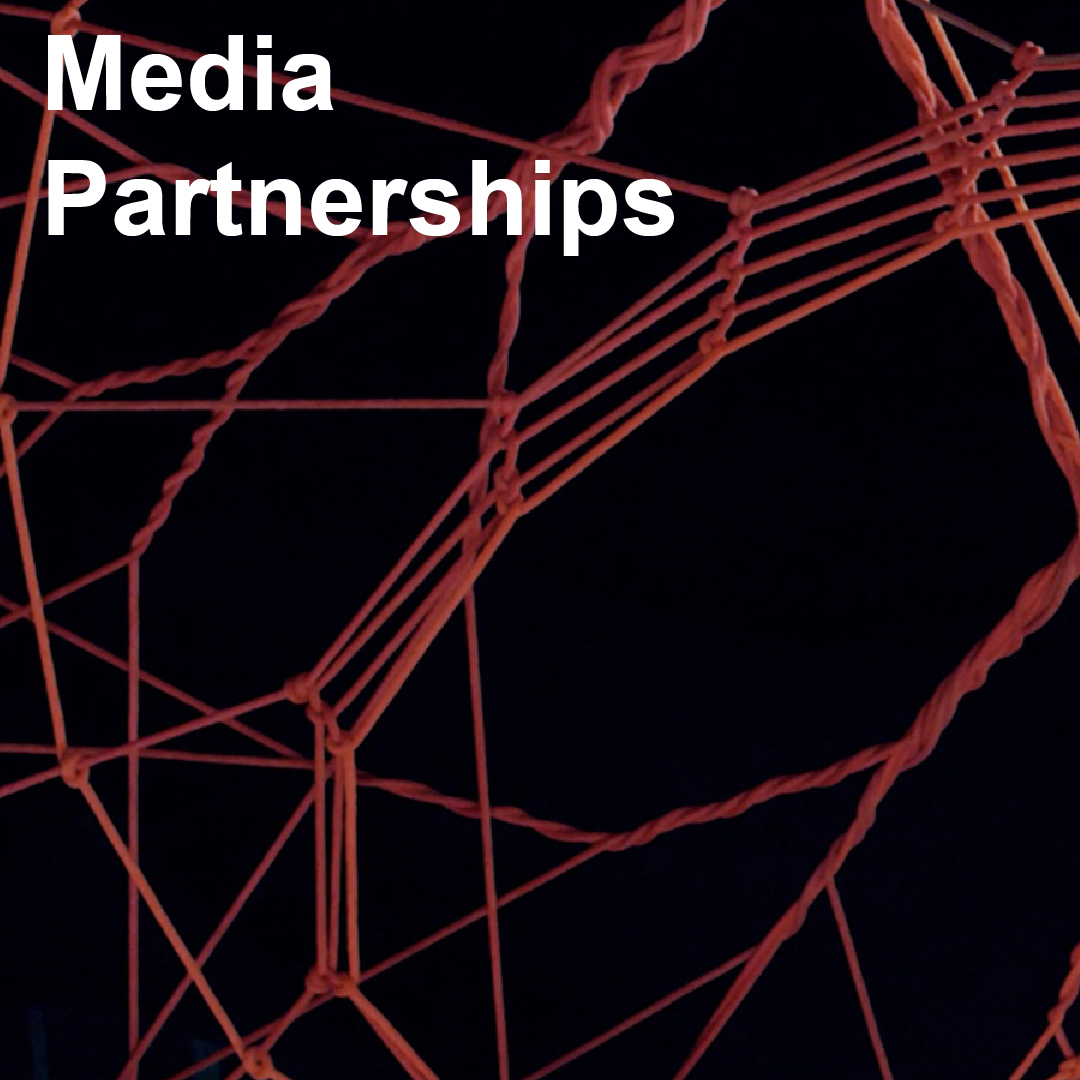EUROPE & ME MAGAZINE No 29: http://www.europeandme.eu/7baby/380-pornographic-revolution?showall=1
- Written by Anna Maria Rupp
For the first time in Europe, this autumn in Berlin a Feminist Porn Film Award was dedicated to the pioneers of the sex-positive movement. The organisers say that their label “PorYes” is not a direct answer but a “necessary alternative” to the PorNo campaign, started in 1987 by Alice Schwarzer, Germany’s most famous feminist. The PorNo campaign wants pornography to be prohibited by law. Meanwhile, the campaigners of PorYes say they aim to redefine porn in a politically and ethically correct way, in reaction to the mass of commercial pornography.
We wanted to find out how this would work out – porn and politics on one screen. So we talked to Laura Méritt, member of the PorYes film award jury, about her thoughts on pornography and how to produce it, and about the efforts of PorYes to create a label for so-called fair porn.
E&M: What are the differences between common and feminist porn films? Sex is sex, isn’t it?
Laura Méritt: Commercial porn shows standardised breasts, penes, bodies – usually in categories according to the kind of porn. Usually, there are porn movies with small breasts and others with big ones, movies for people who fancy white or black skin, etc. The male erection is the only focus and the male orgasm the only ambition and destination of the whole story. Feminist porn wants to create emotions by showing authentic scenes in an aesthetic setting. And the female orgasm is an important part of the story, feminist porn does not show just sperm everywhere. Sex is not at all always and for everybody the same. The nuances are exactly what we want to show.
E&M: Women often say that porn movies are something for men. Are the “PorYes” movies made especially for women?
LM: Not at all. We found out that a lot of men are interested in our work, particularly as it’s pornography of higher quality. Homo-, hetero- and bisexual women and men are our target group, transgender welcome.
E&M: So, do women need porn?
LM: There are a lot of women with a strong desire for it. As there are also men and women who say that they really don’t need it.
E&M: How did the idea of creating an alternative pornographic festival come into the world?
LM: For two years, we have been developing the idea of founding a feminist porn festival. We were inspired by our sisters from Toronto who are doing similar work in Canada – they started about four years ago. Now we’re happy to be promoting feminist porn films in Europe, too.
E&M: Who are the organisers of the PorYes festival?
LM: Our network is called “Network of flowing joys” (Freudenflussnetzwerk): Our work concerns sexualitIES, organising parties, book projects, and movies that stem from sex-positive, fair, anti-racist and non-misogynistic attitudes. The people responsible for our network are mainly, but not only, women from Berlin and from other parts of Germany, Austria and Switzerland. We have some contacts to France, but other European countries are scarcely or not involved. We haven’t heard anything from Scandinavia, England, Eastern Europe or Italy for instance.
E&M: What are the basic principles of your work?
LM: We aspire to a plurality of ages, identities, gender, colour, cultures and opinions. We are against any kind of discrimination, but also against commercialised exploited sex and uniform aesthetics. In our eyes, common porn films are not erotic as they use unimaginative and unattractive methods and film settings. And even today, porn film producers often exploit people who work for them and keep them at the same time trapped in a state of dependency on work which is very low paid but also demanding. Our aim is to show that it is possible to produce pornography that shows all kind of human bodies and their arousal both in an aesthetic manner and on the basis of fair working conditions for all participants.
E&M: Who won the prizes at the first PorYes festival?
LM: We paid femmage to some of the pioneers of feminist porn. Some of them have been doing this kind of work for nearly 20 years already. The group of artists called “S.A.F.E.” were the first to bring topics like safer sex, disabilities or lesbian love into a porn film. Other awards went to Annie Sprinkle, who is one of the most important feminist porn activists from the USA, she is also called “porn queen,” Candida Royalle is the grand lady of feminist porn worldwide and Petra Joy, who was the first to be active in the European feminist porn industry.
E&M: Besides the porn film award you also have created a label called “PorYes.” Do you mean there’s a real need for such a label?
LM: Oh, yes. Until today, no quality definitions exist which enable people to differentiate between the huge quantity of miserable – sexist, racist or really bad – pornography and the few works which try to speak to the emotions and sexual vibrations of both men and women, homosexual and heterosexual, black and white, curvy and thin, old and young. We want to help people who are looking for good porn but who can’t find it. If today, you search for pornographic films on the internet, you’ll bump into that mass of standardised ejaculations.
E&M: What are the requirements for a film to get the PorYes label?
LM: The important thing is the sex-positive attitude of the film. That means that there can’t be any de-humanising or misogynistic portrayals. Working conditions must be ethical and women have to be significantly involved as producers and camerawomen. The sex that is shown is not concentrated on the male ejaculation – female lust is an important part of the message. Sex, the moaning, the lights, the camera settings are not stereotypical, but aesthetic and authentic at the same time. This means that emotions can arise both on screen and in the spectators.
Sex is not shown as an achievement test as in commercial porn that often leads to a false understanding of sexuality, mainly in the young generation. We conceive our work also as a contribution to sex education as our films show that safer sex is anything but daunting.
E&M: Are feminist films more about politics and education than about sexual pleasure?
LM: I cannot feel any sexual pleasure in watching films that humiliate women. Why should normal human behaviour that is respectful towards everybody not be the best basis for joy?
E&M: How did audience and press react to the first porn film award?
LM: Very positively. Many of the main newspapers were present and they mostly reported in a very differentiated way. Both the press and the public were really interested in the subject. The most common opinion was that “the time was ripe” for this “pornographic revolution.” And people got really curious…
E&M: Thanks a lot for the interview!
Laura Méritt was interviewd by Anna Maria Rupp






















